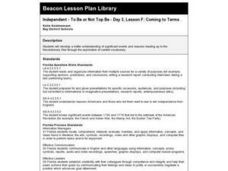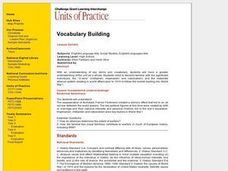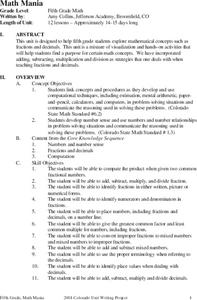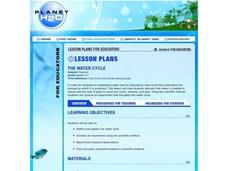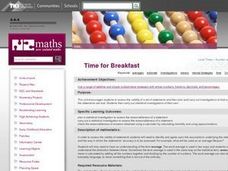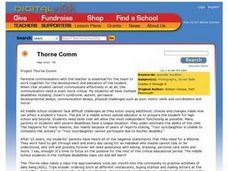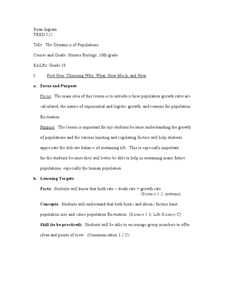Curated OER
Comparing and Contrasting
Learners practice compare and contrast skills. For this science and language development lesson, students complete a T chart generating traits of a snail and a clam. Learners complete a related worksheet.
Curated OER
Will Exams Be Cancelled?
If the flu outbreak continues, exams will have to be canceled. Investigate the properties of exponential and logarithmic functions. In this algebra lesson, students use the TI to examine and differentiate between exponential growth and...
Curated OER
Race and Political Representation
Students explore different perspectives dealing with race and politics.
Curated OER
Hibernating Hoopla
Students simulate hibernation with their stuffed animals. They predict the length of time of hibernation and type their math journal entries about sorting, graphing and draw pictures. They read bear hibernation stories.
Curated OER
The Language of Mathematics
Students integrate the language, concepts and skills of math into the daily routine and classroom environment. They think mathematically by participating in short, daily, individual, small group, whole group and transitional activities...
Curated OER
Weave a Web of Words
Fifth graders write a first draft of an oral presentation about the American Revolution and take their work through the writing process.
Curated OER
Improving Your Spelling with the Virtual Thesaurus
Students study spelling words. In this word study lesson, students use the Visual Thesaurus and play the Visual Thesaurus Spelling Bee.
Curated OER
How Many Months?
Students investigate the first Peter the Mint Eagle, who lived at the Philadelphia Mint from 1830 to 1836. They determine how many months Peter was there and use pictures, numbers, equations, and/or words to explain how they came up with...
Curated OER
Buying My First Car
Students pretend they are about to buy their first new car. They must do all the calculations necessary to estimate the cost of purchasing the car. They see that the math they learn in school really does have real-life applications.
Curated OER
Independent - To Be or Not Top Be - Day 3, Lesson F: Coming to Terms
Fifth graders develop vocabulary through the study of the American Revolution.
Curated OER
Vocabulary Building - World War I
Students study the definitions of militarism, imperialism, and nationalism, and the significant individuals involved in the world alliance system prior to 1914. They examine the events that lead to World War I.
Curated OER
Math Mania
Fifth graders review adding, subtracting, multiplication and division of fractions and decimals through a variety of activities and exercises.
Curated OER
Junk Yard Math
Third graders explore the process of place value and subtraction through regrouping and borrowing exercises. Several activities using manipulatives are utilized in the lesson.
Curated OER
The Water Cycle
Students research the water cycle and identify main vocabulary associated with the water cycle. They build and observe a closed system model that demonstrates the water cycle in action.
Curated OER
Helmet Safety/ Travis's Story
Fourth graders investigate the concept of walking and riding a bicycle as necessary forms of transportation. They watch a video about bicycle safety and write a reflection about notes taken from the video. Students conduct an experiment...
Curated OER
Time For Breakfast
This unit encourages students to assess the validity of a set of statements and then plan and carry out investigations to find out whether the statements are true. Students then carry out statistical investigations of their own.
Curated OER
Grade 2: Texas Problem Solving
Second graders use numerical data about Texas to write and solve real-life problems involving addition and subtraction (or multiplication and division). They work in pairs to choose three numerical facts about Texas to use to make up...
Curated OER
Pepe Cleaners
Seventh graders gather data to determine the relationships between the base and height of rectangles with fixed perimeters and express the relationships using words and symbols. Students build rectangles with pipe cleaners. They create...
Curated OER
Project Thorne Comm
Young scholars participate in a class that is designed for those who have physical and mental disabilities. They take part in class activities and field trips planned around the development of skills for activities of daily living. The...
Curated OER
Plastics and Rubber: What's the Difference?
Students observe how to classify things into groups based on physical properties. In this plastic and rubber instructional activity students group and sort items to help them to better identify properties.
Curated OER
The Dynamics of Populations
Tenth graders analyze the growth rate of different population. In this biology experiment, 10th graders identify the biotic and abiotic factors that limit population size. They create a poster to show their findings in class.
Pennsylvania Department of Education
Alike and Different
Students compare and contrast objects and are introduced to a Venn Diagram. In this alike and different lesson, students make observations regarding properties of objects. Students classify object and build ideas about variables....
Pennsylvania Department of Education
Stories? Information? What's the Difference?
Young scholars listen to a power point presentation to distinguish between fiction and nonfiction text. In this what's the difference activity, students identify fact from opinion within a text. Young scholars listen critically and...
Curated OER
What's In A Name? How Did Surnames Come to Be?
Learners examine how in the early years of the Middle Ages, most people in Europe lived in small farming villages. Everyone knew his neighbors, and there was little need for last names.











